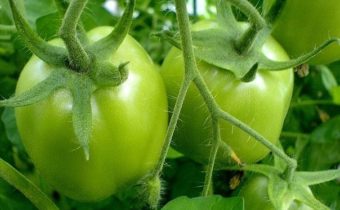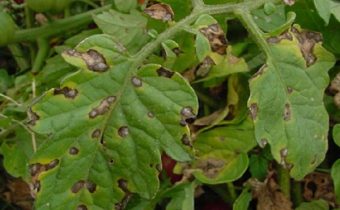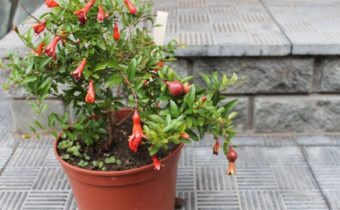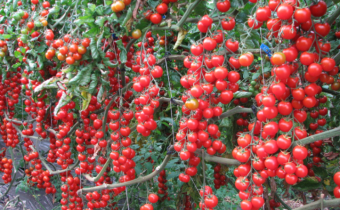Harvesting tomato seeds from their tomatoes - step by step
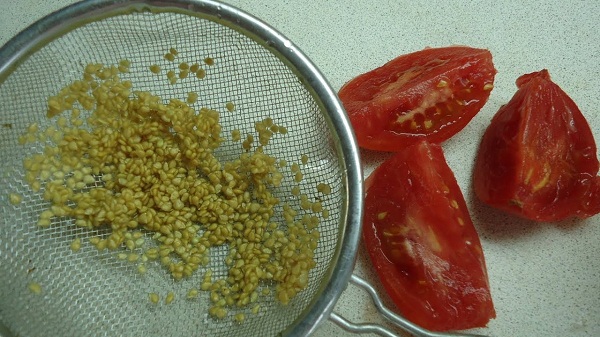
To get quality tomato seeds is quite possible even at home. The selection of the most productive varieties that have got acclimatized in a particular climate is possible precisely in the process of self-selection. Observing not complicated technology of preparation, processing and storage, it is possible to get a sufficient amount of seeds annually.
Selection of fruits
Seed material can be collected from almost any variety, but not from hybrid. The latter are obtained by crossing two different types of plants, by selection it is possible to select the most successful first generation. However, the second generation will not have the same properties.
It will not be possible to get seeds from F1 type hybrids, you can also find varieties with similar names on the market, this should not be misleading.
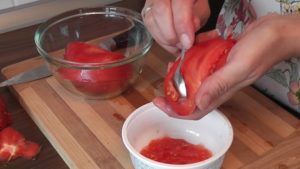 It is recommended to use for preparation typical for this region varieties or species that have shown good yields for several years in a row. Uncharacteristic for the climatic zone, the species may not give fruit for the next year.
It is recommended to use for preparation typical for this region varieties or species that have shown good yields for several years in a row. Uncharacteristic for the climatic zone, the species may not give fruit for the next year.
Start the selection should be more with the choice of plants. It should be:
- strong and healthy bushes;
- time pinned and processed;
- with the best yields.
Tomatoes should be taken medium size and regular shape. It is necessary to be guided by the description of the variety. It is better to take the seeds from the fruit, which has a typical color and size, the correct structure and the corresponding period of ripening. Thus, you can get a "pure grade". Should choose from tomatoes, ripened on the lower brushes. The upper ones are more often pollinated by bees, assuming some properties of hybrids.
It is very important to pick tomatoes in time for seeds. They should not be fully ripe, brown, but not green. Overspeed should not be allowed. If the fruit has become too soft even on a branch, its seeds may germinate during storage or even die. To ripen the fruit should be warm and moderate light.
Processing technologies
Getting ready seed is not difficult. For the collection of seeds will require:
- selected tomatoes;
- glass container with a lid;
- gauze;
- some water;
- some salt;
- cotton shawl.
Without fermentation
Tomato should be cut in half, remove the soft juicy part, put in a glass bowl seeds with juice. All fill with water, cover with a lid and shake. Rinse under running water at room temperature. Then spread out on a cotton towel, leave to dry completely, put in storage.
You can not lay out the prepared material for planting in the sun or near heating devices for better drying, it can literally "kill" the seeds or stimulate their germination.
With fermentation
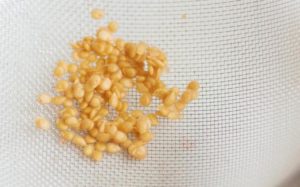 It is easy to ferment the seeds: after separating all the liquid from the tomato, it is necessary to put it in a glass container and cover it with gauze, without adding water or rinsing. During the day, the juice will first grow cloudy, then brighten, covered with light foam. Fermentation ends by lowering the treated seeds to the bottom of the tank. Rinse the resulting mass several times until absolutely pure water is obtained; dry the seeds in the manner described earlier.
It is easy to ferment the seeds: after separating all the liquid from the tomato, it is necessary to put it in a glass container and cover it with gauze, without adding water or rinsing. During the day, the juice will first grow cloudy, then brighten, covered with light foam. Fermentation ends by lowering the treated seeds to the bottom of the tank. Rinse the resulting mass several times until absolutely pure water is obtained; dry the seeds in the manner described earlier.
If there is a lot of inoculum and there are doubts about its quality, it is possible to separate the ripened specimens from the empty and green ones. In a glass of water, dissolve a teaspoon of ordinary salt, place. Gently add all the seeds. Down to the bottom, clean up for storage and then use for planting, dispose of the rest.
Quick way
This option is acceptable in the case when there is no time left for full training. It is necessary to extract the juice with seeds from the fruit, rub the resulting mass gently on a paper towel or thick cloth. Leave to dry for one week. After gently separate only the seeds and put them in storage. Germination can be a little worse, since this method does not allow for full processing, but the results will depend largely on the choice of fruits.
Additional processing
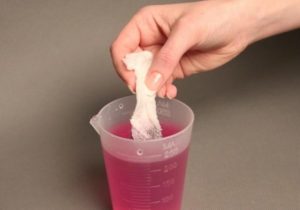 Before planting, the material obtained on its own must be processed, especially if the seeds were obtained not in the previous season, but much earlier. First of all, it is necessary to re-calibrate in a saline solution in order to re-separate the excessively dried and non-viable. After this, hold quenching: lay seed in dampened gauze, send everything in a saucer to the fridge for one day. Thus, resistance to possible frosts is formed.
Before planting, the material obtained on its own must be processed, especially if the seeds were obtained not in the previous season, but much earlier. First of all, it is necessary to re-calibrate in a saline solution in order to re-separate the excessively dried and non-viable. After this, hold quenching: lay seed in dampened gauze, send everything in a saucer to the fridge for one day. Thus, resistance to possible frosts is formed.
Hardening is possible both immediately after drying and before planting.
It is possible to eliminate contamination of the entire crop by common viral and fungal infections by pre-processing. Pharmaceuticals such as Immunititofit and Zircon give excellent effect. An available alternative is concentrated aloe juice, in which seeds are also placed for one day. The correct sequence of actions before planting is as follows:
- quenching
- awakening;
- oxygen saturation;
- disinfection.
Oxygenation will improve the quality of the old seed. Seeds should be placed in a bag of gauze and in warm water, to the tank connect the air filter from the aquarium, set to the minimum capacity. Leave in working condition for one day. The process is also referred to as bubbling. It is not difficult to wake up the seed: put all the available material in cool, melt water, leave it at room temperature for 18 hours. After all manipulations, drying is not required.
Storage rules
 For storage, choose a dry, dark, slightly cool and well ventilated place. This may be a pantry in a house or apartment, a box under the bed, a dry, cool winter storage. If you can not, thus, place the seeds, you can simply put them in cardboard boxes in ordinary cabinets. Do not place the container in the kitchen or in a poorly ventilated cellar.
For storage, choose a dry, dark, slightly cool and well ventilated place. This may be a pantry in a house or apartment, a box under the bed, a dry, cool winter storage. If you can not, thus, place the seeds, you can simply put them in cardboard boxes in ordinary cabinets. Do not place the container in the kitchen or in a poorly ventilated cellar.
One of the most simple and proper storage methods is to place in separate envelopes made of thick paper, for example, parchment or a usual candy store, but in several layers. Dried seeds should be placed loosely on the plane, then rolled up the envelope and stored for storage in a dry place.
One of the reliable ways is to save it in a special silica gel. Pellets can be left in bags and simply decomposed in each of the containers. Thus, the seeds can be placed even in glass jars, but with an airtight lid.
Typical mistakes
One of the main mistakes is the choice of an atypical bush. If a variety suddenly gives a high shoot, with a yield several times higher than the declared one, this is most likely a combination of circumstances and climatic factors, then this result is unlikely in the future.
It is not recommended to choose tomatoes from the bushes, where all the fruits are of different sizes for the same reasons.
In the process of processing, blanks do not use aluminum or iron utensils, it is better to choose clay, enamel or ordinary glass.Ready-made seeds are not stored for more than four years, even if they have been carefully processed.


